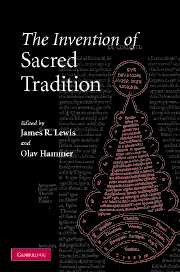Book contents
- Frontmatter
- Contents
- List of figures
- Notes on contributors
- Introduction
- 1 Scientology, scripture, and sacred tradition
- 2 “He may be lying but what he says is true”: the sacred tradition of don Juan as reported by Carlos Castaneda, anthropologist, trickster, guru, allegorist
- 3 The invention of sacred tradition: Mormonism
- 4 Antisemitism, conspiracy culture, Christianity, and Islam: the history and contemporary religious significance of the Protocols of the Learned Elders of Zion
- 5 The invention of a counter-tradition: the case of the North American anti-cult movement
- 6 “Heavenly deception”? Sun Myung Moon and Divine Principle
- 7 “Forgery” in the New Testament
- 8 Three phases of inventing Rosicrucian tradition in the seventeenth century
- 9 A name for all and no one: Zoroaster as a figure of authorization and a screen of ascription
- 10 The peculiar sleep: receiving The Urantia Book
- 11 Ontology of the past and its materialization in Tibetan treasures
- 12 Pseudo-Dionysius: the mediation of sacred traditions
- 13 Spurious attribution in the Hebrew Bible
- 14 Inventing Paganisms: making nature
- Index
- References
8 - Three phases of inventing Rosicrucian tradition in the seventeenth century
Published online by Cambridge University Press: 22 September 2009
- Frontmatter
- Contents
- List of figures
- Notes on contributors
- Introduction
- 1 Scientology, scripture, and sacred tradition
- 2 “He may be lying but what he says is true”: the sacred tradition of don Juan as reported by Carlos Castaneda, anthropologist, trickster, guru, allegorist
- 3 The invention of sacred tradition: Mormonism
- 4 Antisemitism, conspiracy culture, Christianity, and Islam: the history and contemporary religious significance of the Protocols of the Learned Elders of Zion
- 5 The invention of a counter-tradition: the case of the North American anti-cult movement
- 6 “Heavenly deception”? Sun Myung Moon and Divine Principle
- 7 “Forgery” in the New Testament
- 8 Three phases of inventing Rosicrucian tradition in the seventeenth century
- 9 A name for all and no one: Zoroaster as a figure of authorization and a screen of ascription
- 10 The peculiar sleep: receiving The Urantia Book
- 11 Ontology of the past and its materialization in Tibetan treasures
- 12 Pseudo-Dionysius: the mediation of sacred traditions
- 13 Spurious attribution in the Hebrew Bible
- 14 Inventing Paganisms: making nature
- Index
- References
Summary
The obscurely phrased announcement in 1614 that a secret Rosicrucian brotherhood had been established to cause a radical religious reform was to provoke many reactions. Even if one recognized their traits of Christian kabbalism, alchemy, and apocalypticism, Rosicrucian writings were written under the seal of secrecy, signed by pseudonyms or acrostics formed from the authors' initials, and no one seemed to know their true origin. Although they were anonymous, the Rosicrucian manifestos spread intense expectations of a new age, an era of heavenly grace and spirit created by a general reformation of religion and society, and a renewal of all sciences and arts. All natural connections in the cosmos that were hidden or scattered would now be brought together, researched, and revealed. The first Rosicrucian manifesto, The Fame of the Brotherhood of the Rosy Cross, Addressed to All Learned and to All Heads of State in Europe, spoke of a German knight, Christian Rosenkreutz, who had travelled to the Orient and had returned with arcane and mystical knowledge. The Fama claimed that his hidden grave had recently been rediscovered, 120 years after it was sealed. It was said to contain encyclopedic and revelatory texts, as well as an ever-burning lamp to be used for the recovering and further spread of this knowledge.
The author of the initial Rosicrucian manifestos, Fama fraternitatis roseae crucis and Confessio fraternitatis roseae crucis (Kassel, 1614–15), is now generally agreed to be the theology student Johann Valentin Andreae, inspired by the apocalypticist Tobias Hess and indebted to the esoteric library of the law professor Christoph Besold, all living in the Lutheran university town of Tübingen.
- Type
- Chapter
- Information
- The Invention of Sacred Tradition , pp. 158 - 176Publisher: Cambridge University PressPrint publication year: 2007
References
- 2
- Cited by



